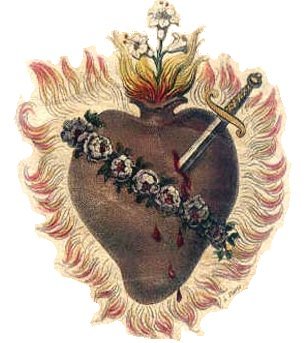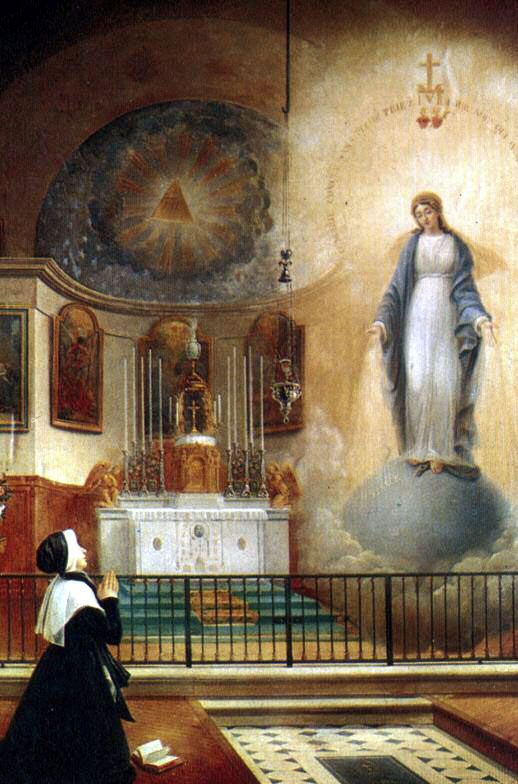|
Luke 2:19: But Mary kept all these words, pondering them
in her heart.
Luke 2:35: And thy own soul a sword shall pierce, that, out of many
hearts thoughts may be revealed.
Luke 2:51: And he went down with them and came to Nazareth and was
subject to them.
And his mother kept all these words in her heart.
Devotion to the Sacred Heart of Jesus focuses
mostly on His divine love for mankind and encourages our humility,
gratitude, obedience, and adoration; devotion to the Immaculate Heart
of Mary focuses on Mary's love for God and encourages our emulating her
humility, gratitude, obedience, and adoration. Mary as
loving Mother of Jesus Who suffered for us; Mary as Mother of the
Church; Mary as obedient daughter, Mary as our Gevirah (Queen Mother of
Israel) -- we ponder her interior life in each of these roles, consecrate ourselves to Jesus through her,
make reparations for offending her as our Mother, ask her intercession
for us with her Son, and emulate her as the model of Christian
perfection.
The Feast of Candlemas,
which commemorates Mary's ritual Purification and her Presentation of
Jesus in the Temple, sheds special light on the nature of devotion to
her Immaculate Heart. The old man, Simeon, foretold that "a sword"
shall pierce Mary's heart, and meditating on the sorrows symbolized by
that sword helps us to understand what Our Lord went through for us.
But she knew even before Simeon's words to her; when she uttered to God
"Let it be done to me according to Thy will," she knew that she would
give birth to the One destined to die to redeem us. She knew that she
would have to offer up her Son. And she chose that suffering. Speaking
of Mary's joy at Christ's birth, Pope John XXIII said,
This joy, however, is also
a scarlet flower of sacrifice: the sacrifice of the Blessed Mother of
Jesus, who, having spoken her timely "fiat," at the same time agreed to
share in the fate of her Son, the poverty of Bethlehem, in the
self-denial of a hidden life, and in the martyrdom of Calvary.
We
meditate on Mary's immaculate heart not only on Candlemas, but on the
two feasts honoring Mary's sorrows -- one
during Lent, and one in
September; during all of Passiontide (the two weeks
before Easter), as we make the Stations of the
Cross; during August, which
is devoted to the Immaculate Heart; on August 22 especially, which is
the Feast of the Immaculate
Heart; during September, which is devoted
to the Seven Sorrows, etc. And throughout the year, we may make the Novena to the Immaculate Heart or pray the Litany of the Immaculate
Heart of Mary.
While, early on, of course, the Church Fathers wrote of Mary's
blessedness, purity, and sorrows, and our Saints -- Dominic, Gertrude,
Thomas Becket, Bridget, Bernardine of Siena, Louis de Montfort -- have
always had deep Marian devotions, it was after the apparitions of Mary experienced by St.
Catherine Labouré at Rue Du Bac, Paris in 1830 that devotions
specifically to Mary's Immaculate Heart became formalized.

Specific Devotions
On
July 19, 1830, Catherine Labouré, a Daughter of Charity of
St. Paul, was awakened when she heard a child's voice beckoning to her
from the chapel. When she got to the chapel, Mary appeared to her,
saying, "God wishes to charge you with a mission. You will be
contradicted, but do not fear; you will have the grace to do what is
necessary. Tell your spiritual director all that passes within you.
Times are evil in France and in the world."
The Virgin was standing on a globe, rays of light streaming from her
fingers, enframed in an oval frame inscribed with the words, "O Mary,
conceived without sin, pray for us who have recourse to thee." The
whole vision "turned" showing the back of the oval inscribed with the
letter "M" entwined with a Cross, and the hearts of Jesus and Mary, the
former surrounded with thorns, the latter pierced with a sword. 12
stars circled this oval frame. Mary told her to strike a medal in this
form -- a medal now known as the "Miraculous
Medal" -- and that all who wore it properly after having it blessed
would receive graces. The wearing of the Miraculous Medal has become
one of the most common devotions to the Immaculate Heart.

Devotion
to the Immaculate Heart became even more popularized after Mary's
appearing to the three young shepherd children at Fatima, Portugal in 1917 (before
the Russian Revolution), when she asked that Russia be consecrated to
her Immaculate Heart to prevent the spread of "the errors of Russia."
Eight years later, in 1925, Mary appeared to one of the visionaries --
Lucia, who'd since become a nun -- and requested reparations for the
various ways in which her Immaculate Heart was offended -- such as
attacks against her Immaculate Conception, virginity and divine
maternity, and for those who teach their children contempt of Mary or
who insult her by desecrating her images.
To make these reparations, she asked that we do five things, all with
the
intention of making reparation to her Immaculate Heart:
- recite
at least Five Decades of the Rosary every day
- wear
the Brown Scapular
- offer
our daily duty to God as an act of sacrifice (ie., make the Morning Offering)
- make
Five First Saturdays of Reparation to Her Immaculate Heart (see below)
- the
Pope, in union with all the bishops of the world, must consecrate
Russia to Her Immaculate Heart. Russia would be converted through this
means, and a period of peace to be given to the world. If this is not
done, Russia will "spread her errors throughout the world."
The
"First Saturdays of Reparation" (typically referred to simply as "First
Saturdays") was not a new devotion, but it was even more popularized
after Our Lady appeared at Fatima. It consists of, on the first
Saturday of each month for five consecutive months:
- going
to Confession (may be 8 days before the
Saturday as long as one stays in a state of grace)
- attending
Mass and receiving the Eucharist
- praying
5 decades of the Rosary, including the
Fatima Prayer
- "keeping
her company" for 15 minutes while meditating on all of the Mysteries of
the Rosary with the intention of making reparation to her. This can be
done by reading Scripture or other writings relevant to the Mysteries,
meditating on pictures of the Mysteries, or simple meditation. This
prayer is a traditional one to pray in order to make reparation:
Most holy Virgin and our
Mother, we listen with grief to the complaints of thy Immaculate Heart
surrounded with the thorns which ungrateful men place therein at every
moment by their blasphemies and ingratitude. Moved by the ardent desire
of loving thee as our Mother and of promoting a true devotion to thy
Immaculate Heart, we prostrate ourselves at thy feet to prove the
sorrow we feel for the grievances that men cause thee, and to atone, by
means of our prayers and sacrifices, for the offenses with which men
return thy tender love.
Obtain
for them and for us the pardon of so many sins. A word from thee will
obtain grace and amendment for us all.
Hasten,
O Lady, the conversion of sinners, that they may love Jesus and cease
to offend the Lord, already so much offended, and will not fall into
hell.
Turn
thine eyes of mercy towards us, that henceforth we may love God with
all our heart while on earth and enjoy Him forever in heaven. Amen.
The
promise given by Mary to those who make the First Saturday devotion is
her assistance at the hour of their death.
 Back to Being Catholic Back to Being Catholic
 Index Index
|

